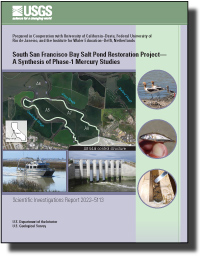Abstract
The South Bay Salt Pond Restoration Project (SBSPRP) encompasses over 6,000 hectares of former salt production ponds along the south edge of the San Francisco Bay and represents the largest wetland restoration effort on the west coast of North America. A series of studies associated with Phase 1 (2010–2018) restoration activities that are focused on a historically mercury contaminated slough and series of ponds within the restoration area have recently been completed.
This report brings together the key findings of these loosely coordinated studies and integrates the results into a more comprehensive and holistic product that informs future restoration activities associated with the SBSPRP and elsewhere. This report documents key findings associated with the breach of pond A6: (1) a short-term spike in slough fish (Mississippi silverside) total mercury concentration in lower Alviso Slough; (2) a short-term spike in surface-water particulate total mercury in lower Alviso Slough; (3) significant sediment scour in Alviso Slough adjacent to and downstream of the breach points; (4) a decrease in surface-sediment methylmercury (as a percentage of total mercury) in lower Alviso Slough; (5) the transport of 70 kilograms per year of sediment-associated total mercury into pond A6 during the first 2 years following the breach but with much of this coming from outside of Alviso Slough, presumably from the nearby shallows, Guadalupe Slough, and the larger southern San Francisco Bay area; and (6) a slowing of bed sediment erosion in lower Alviso Slough 3–5 years after the breaching of pond A6.
Although this report is not intended to be prescriptive in terms of the next steps the SBSPRP should or should not take, the totality of the findings presented provide critical process-level information regarding the extent and the duration of spikes in mercury levels in water, sediment, fish, and birds, which appeared to result from the two management actions under study. Thus, these results can be used to anticipate similar ecosystem responses associated with similar management actions that may be considered in the future. We also conclude this report by highlighting unanswered questions associated with mercury dynamics as it relates to the restoration project, and possible future directions for research.
Suggested Citation
Marvin-DiPasquale, M., Slotton, D., Ackerman, J.T., Downing-Kunz, M., Jaffe, B.E., Foxgrover, A.C., Achete, F., and van der Wegen, M., 2022, South San Francisco Bay Salt Pond Restoration Project—A synthesis of Phase-1 mercury studies, U.S. Geological Survey Scientific Investigations Report 2022-5113, 147 p., https://doi.org/10.3133/sir20225113.
First posted March 7, 2023
For additional information, contact:
Director,
Water Resources, Earth System Processes Division
U.S. Geological Survey
345 Middlefield Road
Menlo Park, California, 94025




